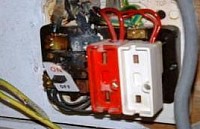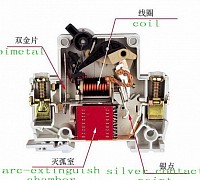Fuse Boards Danger and understanding.
If YOU HAVE AN OLD FUSE BOARD LIKE THE ONE IN THIS PHOTO PLEASE GET IT CHANGED
GIVE US A CALL FOR A QUOTE
Why change to a 17th edition fuse board
Safety
Old fuse will not trip as quick under load conditions as a modern day MCB also the risk of somebody putting the incorrect fuse wire in, thus it has a higher risk of shock and fire to that of a MCB.
The new up to date consumer board will be split load comprising of two RCD thus higher protection to the risk of electric shock.
The modern board will also be safer as not all circuits will disconnect at the same time.
By updating your board you will comply with all the changes in the regs that means you can add new circuits without worrying if it complies.
All sockets have to be RCD protected.
See below how it all works
A consumer unit is the "fuse box" which goes between the electricity meter and all the electrical circuits in the house. Modern units do not contain fuses, but MCBs. They often also contain an extra protective device called an RCD, which replaces the isolator switch. In some cases, the RCD (described below) does not protect all the circuits, in which case there is also an isolator switch to disconnect everything. This type of arrangement is called a "split load" consumer unit. Modern consumer units can also contain other devices such as time switches and door-bell transformers, which fit in a modular fashion.
Miniature Circuit Breakers (MCBs)An MCB is a modern replacement for a fuse, the purpose of which is to protect the wiring of its circuit from excessive current due to an overload or short-circuit. If the rated current is exceeded, the MCB will trip, and merely needs to be switched back on again to re-connect. It is thus more convenient than a fuse, and more obvious that it has tripped. Common values are 6A for lighting circuits, 16A for single sockets and immersion heaters, 32A for ring mains, 7kW electric showers and electric cookers, and 40A for 8kW showers and larger electric cookers.
MCBs are cheap at just over five pounds each. They are available to replace fuses in some makes of consumer unit. Their operating characteristics are much better defined than that of a fuse, and they are not open to abuse such as rewiring with the wrong grade of fuse wire, or holding in the "on" position.
Residual Current Devices (RCDs)
Principle of RCD Operation
An RCD protects by constantly monitoring the current
flowing in the live and neutral wires supplying a
circuit or an individual item of equipment. Under
normal circumstances, the current flowing in the two wires is equal.
When an earth leakage occurs due to
a fault in the circuit or an accident with the equipment,
an imbalance occurs and this is detected by the
RCD, which automatically cuts off the power before
injury or damage can result.
RCDs (sometimes called Earth Leakage Circuit Breakers) are primarily designed to protect against electrocution (i.e. *death* from electric shock) by detecting current flowing to earth. Because under normal circumstances there should be very little earth current, they can be made very sensitive: 30 milliamps is common. Compare this with, say, 6 amps for a lighting MCB and it is obvious that an RCD provides far greater protection. This sensitivity also gives it the ability to detect other faults such as partial live/earth breakdown, which generates heat and can cause fires. However, it cannot protect against the less common live-neutral shock, and it does not protect against overloads so must always be used in conjunction with MCBs or fuses. A device called a Residual Current Breaker with Over-current protection (an RCBO) performs the functions of earth leakage and over current protection, and is basically an RCD and an MCB combined. Some RCDs/RCBOs have extra features, such as detection of live/neutral reversal or earth disconnection (for which they need an earth sense wire). A disadvantage of some RCBOs is that you cannot tell if they were tripped by over current, or an earth fault. This can make fault finding harder.
RCDs have to be designed to interrupt fault currents, indeed they often beat the fuse/MCB in doing so. In the case of a fault current to earth, RCD must trip within 0.04 seconds (unless time delayed type), whereas fuse/MCB is allowed 0.4 or 5 seconds (depending on circumstances).
RCDs are current operated, but there is also the older voltage operated Earth Leakage Circuit Breaker (ELCB). There is some confusion over names, so I will refer to the function. The voltage operated type has a solenoid connected between the earth of the protected area (e.g. all the sockets and pipes in the house) and "true" earth (the sheath of the incoming supply cable or an earth rod). When there is sufficient voltage across the solenoid, which I believe is of the order of 50V, corresponding to a few tens of milliamps, the RCD will trip, disconnecting the circuits protected by it. It then has to be reset manually.
Voltage operated devices have the disadvantage that as they measure earth leakage directly, they can only detect leakage to the earth circuit that passes through them. Thus, they will not detect current passing through the body to the ground when using equipment outdoors, or to current passing through the body to plumbing if it is connected to the ground (e.g. by the rising main) and therefore cannot be included in the protection circuit. It is even possible that earth faults in other properties on the same water main can cause the unit to trip!
It seems to me also that the solenoid is a weak link in the earth circuit, and if this becomes disconnected, a short to earth will result in the earth circuit becoming live.
Current operated RCDs are the norm in modern consumer units. They have no connection to earth circuits at all, and so will detect leakage to any earthed object. Instead, they rely on detecting imbalances between the live and neutral currents which must be going somewhere: to earth. This is accomplished simply by passing both live and neutral through a metal ring, which then acts as a transformer with two single turn windings. If the current through live and neutral is the same, no magnetic flux will be generated in the core; if they are different, then the resultant flux is detected by another winding on the core. The RCD has no significant effect on the flow of live and neutral current through it.
A small amount of earth leakage is to be expected in normal situations, such as from damp fluorescent fittings and mains filters on appliances, and there are all sorts of nasty spikes which can occur on the mains supply and be interpreted as a fault. RCDs are therefore designed to offer a compromise between the degree of protection offered and the risk of "nuisance tripping". There are many factors which determine whether or not someone will survive an electric shock, but two of these are duration of exposure and the current flowing. RCDs are designed to have a tripping characteristic which takes account of both of these: typically 30mA for 0.04s. Units with larger trip currents are available, but are primarily intended to protect against fire when the earth may be too poor to allow a fault current sufficient to trip MCBs. To comply with the IEE Wiring Regulations, all sockets which could have outdoor equipment plugged into them must be protected with an RCD.
The RCD DOES NOT GUARANTEE PROTECTION AGAINST ELECTROCUTION, and electrical circuits protected by it should be treated with the same respect as any other. But it does help greatly to ensure that an electric shock is an unpleasant rather than a fatal experience.
RCDs have a test button which creates an earth leak with a resistor, and it is usually recommended that they are tested once a month. An information label near the consumer unit explains this (without telling you that you will have to reset some of your electric clocks afterwards!). The resistor passes more current than that required for tripping, and the duration of the test is not limited, so testing in this way does not provide proof that the unit is working to specification. RCDs can also be switched off manually and can take the place of the isolator switch in the consumer unit, if they break live and neutral.
Compared with MCBs, RCDs are expensive (about 40 pounds upwards) and quite bulky. There is also no need to have one for each circuit, because the voltage to all the circuits is the same, so (all other factors being equal) the fault current in the event of an electric shock will be the same. There is usually just one RCD, which will be used instead of the main isolator switch in the consumer unit, or used in addition to a main isolator in a split load consumer unit (described below). If the RCD trips, in the case of live/earth leakage the cause can be determined by opening/removing all the MCBs/fuses on circuits protected by it and then reactivating/replacing one by one until the RCD trips again. For neutral/earth leakage, it will be necessary to remove neutral connections to isolate the fault. (Neutral and earth are rarely at the same potential due to the voltage drop across the neutral wire's length caused by current flowing through it.)
If the whole house is protected by an RCD, then any genuine or nuisance trip will cause all the lights to fail. This can be dangerous, especially if somebody has just received an electric shock. A split load consumer unit avoids this by having a main isolating switch feeding the lighting circuit fuses/MCBs directly and the rest via an RCD. The split can usually be chosen by cutting a bus-bar. Electric shocks to earth are not often incurred from lighting circuits, so electrical safety is not greatly compromised. It is normal to feed a freezer from an unprotected circuit so that in the event of a trip while the house is unoccupied, it will continue to function. Garages and outhouses are also often fed in this way if they have their own RCD, so that the main RCD will not trip in the event of a fault. (The second RCD is used where there are likely to be frequent nuisance trips or where a greater degree of protection is required, by employing a more sensitive unit. It can be fed from the main RCD provided that its trip current and trip time are both smaller so that it will always operate first.)




